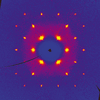issue contents
March 2023 issue

Cover illustration: The plastic phase of cyclohexane (polymorph I) was originally studied by Kahn and co-workers in 1973, without achieving a satisfactory determination of the atomic coordinates. The positions of the C atoms cannot be determined directly as a consequence of the disorder in a high-symmetry space group, an inherent feature of plastic materials. Given this situation, the building of a polyhedron describing the disorder was the main tool for determining the molecular structure in the present work. Diffraction images for the plastic phase I of cyclohexane at 255 K show that molecules are disordered over 24 positions, through four-, three- and twofold rotation axes in space group Fm3m, forming clusters in which the C atoms are located on the vertices of a rhombic dodecahedron. See: Bernès & Camargo [IUCrData (2023). 8, x230114].
raw data letters


 access
accessmetal-organic compounds


 access
access

 access
accessorganic compounds


 access
access

 access
access

 access
access

 access
access

 access
access

 access
access
 journal menu
journal menu




















![[publCIF]](/logos/authorchecklist11.gif)





